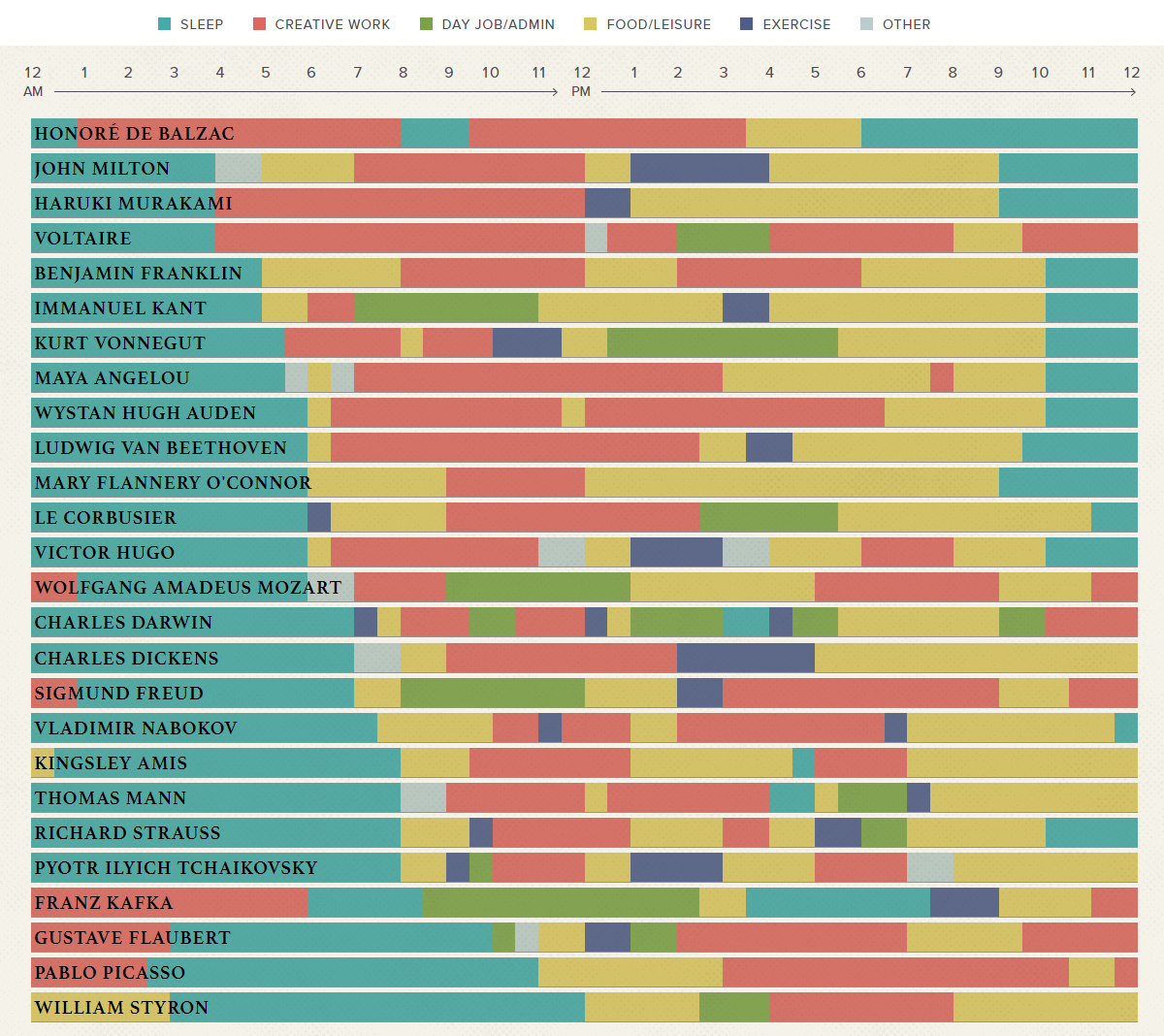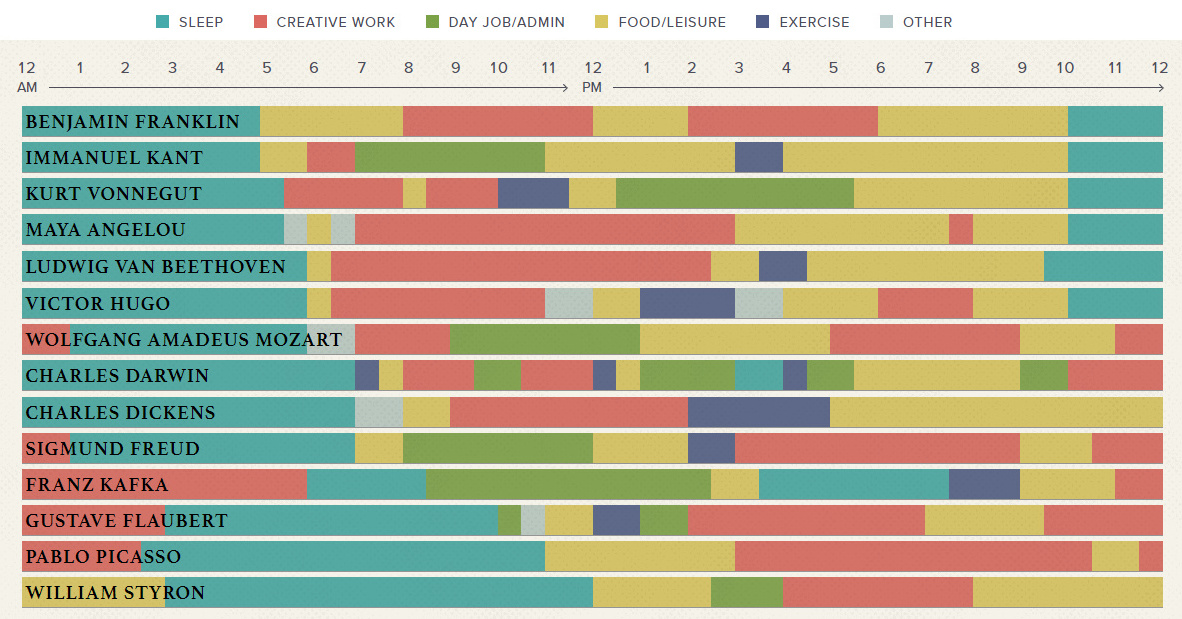Misc
Visualizing the Daily Routines of Famous Creative People

Visualizing the Daily Routines of Famous Creative People
Creative people have a reputation for circumventing convention.
After all, if creatives always did things the same way as everyone else, how could they ever produce anything original and truly unique?
While it’s not always easy to do things differently, the most famous creative people throughout history have almost always followed their own paths. The end result, thankfully for us, is a wealth of original art that has served to inspire generation upon generation.
Time Well Spent
Today’s chart comes to us from Podio and it breaks down the daily routines of famous creative people, such as Pablo Picasso, Mozart, Maya Angelou, or Benjamin Franklin.
We highly recommend the interactive version which allows you to highlight segments of the chart to see more specific details on the routines of each creative person.
It’s also worth noting that the routines listed don’t necessarily represent the exact everyday activities for the listed creatives – instead, they are representations of what’s been recorded in diaries, journals, letters, or other literature by these greats themselves.
Finally, most of the data comes from the book Daily Rituals: How Artists Work by Mason Currey.
Unconventional Habits of Creative Geniuses
Here are some of the creatives that had some of the most unusual and eccentric routines:
Ludwig van Beethoven
The famous German composer and pianist was a coffee addict, and would count exactly 60 beans for each cup of joe he consumed.
Franz Kafka
The novelist would have strong bouts of insomnia and often hallucinated. This condition shaped his creative process, and he stated in his journal that he only knew the type of writing in which “fear [kept him] from sleeping”.
Honoré de Balzac
The French novelist and playwright “[went] to bed at six or seven in the evening, like the chickens” and started working just after midnight. When he worked, he wore “Moroccan slippers” and a “notorious white monkish robe with a belt of Venetian gold”. In his defense, with this type of routine, he was able to write 85 novels in 20 years.
W.H. Auden
The English-American poet took Benzedrine – an amphetamine – every morning for 20 years as a systematic part of his routine and creative process. He balanced its use with the barbiturate Seconal, for when he wanted to sleep. He called amphetamines a “labor-saving device” that gave direct energy to his work.
Victor Hugo
The French poet, novelist, and dramatist, best known for penning Les Misérables and The Hunchback of Notre-Dame, had very busy and eclectic days.
His breakfast would include coffee and two raw eggs, and after working for a few hours in the morning, he would take an ice bath on the roof. In the afternoon, he would try to fit in a quick visit with his barber, a date with his mistress, and also some strenuous exercise. In the evening, he would write some more, and then play cards and go out with friends.
The Reputation Lives On
Rightfully or wrongfully deserved, the reputation of creative geniuses for doing things differently is something that will likely continue to live on – and the rest of the world will likely pass judgement so long as they continue to receive the fruits of their labors.
VC+
VC+: Get Our Key Takeaways From the IMF’s World Economic Outlook
A sneak preview of the exclusive VC+ Special Dispatch—your shortcut to understanding IMF’s World Economic Outlook report.

Have you read IMF’s latest World Economic Outlook yet? At a daunting 202 pages, we don’t blame you if it’s still on your to-do list.
But don’t worry, you don’t need to read the whole April release, because we’ve already done the hard work for you.
To save you time and effort, the Visual Capitalist team has compiled a visual analysis of everything you need to know from the report—and our upcoming VC+ Special Dispatch will be available exclusively to VC+ members on Thursday, April 25th.
If you’re not already subscribed to VC+, make sure you sign up now to receive the full analysis of the IMF report, and more (we release similar deep dives every week).
For now, here’s what VC+ members can expect to receive.
Your Shortcut to Understanding IMF’s World Economic Outlook
With long and short-term growth prospects declining for many countries around the world, this Special Dispatch offers a visual analysis of the key figures and takeaways from the IMF’s report including:
- The global decline in economic growth forecasts
- Real GDP growth and inflation forecasts for major nations in 2024
- When interest rate cuts will happen and interest rate forecasts
- How debt-to-GDP ratios have changed since 2000
- And much more!
Get the Full Breakdown in the Next VC+ Special Dispatch
VC+ members will receive the full Special Dispatch on Thursday, April 25th.
Make sure you join VC+ now to receive exclusive charts and the full analysis of key takeaways from IMF’s World Economic Outlook.
Don’t miss out. Become a VC+ member today.
What You Get When You Become a VC+ Member
VC+ is Visual Capitalist’s premium subscription. As a member, you’ll get the following:
- Special Dispatches: Deep dive visual briefings on crucial reports and global trends
- Markets This Month: A snappy summary of the state of the markets and what to look out for
- The Trendline: Weekly curation of the best visualizations from across the globe
- Global Forecast Series: Our flagship annual report that covers everything you need to know related to the economy, markets, geopolitics, and the latest tech trends
- VC+ Archive: Hundreds of previously released VC+ briefings and reports that you’ve been missing out on, all in one dedicated hub
You can get all of the above, and more, by joining VC+ today.
-

 Markets1 week ago
Markets1 week agoU.S. Debt Interest Payments Reach $1 Trillion
-

 Business2 weeks ago
Business2 weeks agoCharted: Big Four Market Share by S&P 500 Audits
-

 Real Estate2 weeks ago
Real Estate2 weeks agoRanked: The Most Valuable Housing Markets in America
-

 Money2 weeks ago
Money2 weeks agoWhich States Have the Highest Minimum Wage in America?
-

 AI2 weeks ago
AI2 weeks agoRanked: Semiconductor Companies by Industry Revenue Share
-

 Markets2 weeks ago
Markets2 weeks agoRanked: The World’s Top Flight Routes, by Revenue
-

 Demographics2 weeks ago
Demographics2 weeks agoPopulation Projections: The World’s 6 Largest Countries in 2075
-

 Markets2 weeks ago
Markets2 weeks agoThe Top 10 States by Real GDP Growth in 2023




